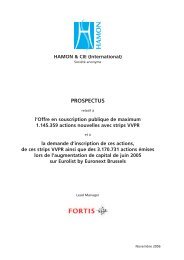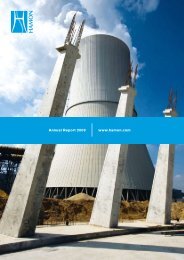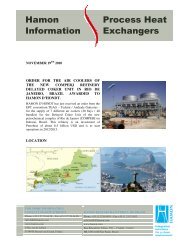Download PDF version English (3237KB) - Hamon
Download PDF version English (3237KB) - Hamon
Download PDF version English (3237KB) - Hamon
You also want an ePaper? Increase the reach of your titles
YUMPU automatically turns print PDFs into web optimized ePapers that Google loves.
ANNEXURES<br />
121<br />
GRI correspondence grid<br />
For our third annual report based on the Global Reporting Initiative (GRI) G3 guidelines, we estimate that we<br />
reach a C level (self-declared). Here is the correspondence grid allowing to find in this annual report the various<br />
sections covered by the GRI canvas.<br />
Ref.<br />
Indicator<br />
Reported<br />
Page<br />
Part I - Profile disclosure<br />
1 Strategy and analysis<br />
1.1 Statement from the most senior decision maker of the organization<br />
Fully 8-11<br />
2 Organizational profile<br />
2.1 Name of the organization<br />
2.2 Primary brands, products, and/or services<br />
2.3 Operational structure of the organization, including main divisions,<br />
operating companies, subsidiaries, and joint ventures<br />
2.4 Location of organization’s headquarters<br />
2.5 Number and names of countries where the organization operates<br />
2.6 Nature of ownership and legal form<br />
2.7 Markets served (including geographic breakdown, sectors served<br />
and types of customers/beneficiaries)<br />
2.8 Scale of the reporting organization<br />
2.9 Significant changes during the reporting period regarding size, structure, or ownership<br />
2.10 Awards received in the reporting period<br />
Fully 62<br />
Fully 44-53<br />
Fully 12-13; 72<br />
Fully 62<br />
Fully 12-13; 72<br />
Fully 62; 92<br />
Fully 12-13; 76<br />
Fully 7; 17-18<br />
Fully 38-41<br />
Fully 21<br />
3 Report parameters<br />
3.1 Reporting period for information provided<br />
3.2 Date of most recent previous report<br />
3.3 Reporting cycle<br />
3.4 Contact point for questions regarding the report or its contents<br />
3.5 Process for defining report content<br />
3.6 Boundary of the report<br />
3.7 State any specific limitations on the scope or boundary of the report<br />
3.8 Basis for reporting on joint ventures, subsidiaries, leased facilities, outsourced<br />
operations, and other entities that can significantly affect comparability<br />
from period to period and/or between organizations<br />
3.10 Explanation of the effect of any re-statements of information provided in earlier reports<br />
3.11 Significant changes from previous reporting periods in the scope, boundary<br />
or measurement methods applied in the report<br />
3.12 Table identifying the location of the Standard Disclosures in the report<br />
Fully 118<br />
Fully 118<br />
Fully 118<br />
Fully 125<br />
Fully 119<br />
Fully 118-119<br />
Fully 118-119<br />
Fully 63-64<br />
Fully 119<br />
Fully 81<br />
Fully 121-122<br />
4 Governance, commitments, and engagement<br />
4.1 Governance structure of the organization<br />
4.2 Indicate whether the Chairman of the highest governance body is also an executive officer<br />
4.3 Number of members of the board of directors who are independent<br />
and/or non-executive members<br />
4.4 Mechanisms for shareholders and employees to provide recommendations<br />
or direction to the highest governance body<br />
4.14 List of stakeholder groups engaged by the organization<br />
4.15 Basis for identification and selection of stakeholders with whom to engage dialogue<br />
Fully 24-31<br />
Fully 26<br />
Fully 26<br />
Fully 36<br />
Fully 34-36<br />
Party 36














